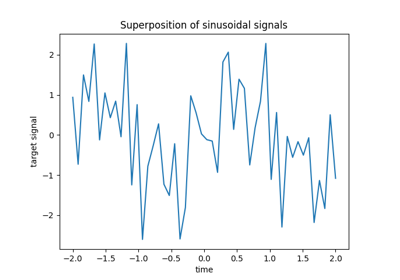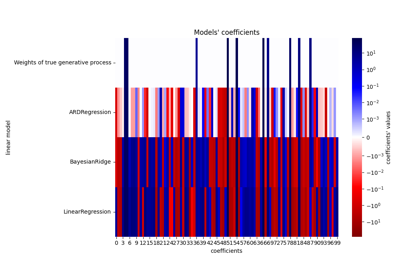ARDRegression#
- class sklearn.linear_model.ARDRegression(*, max_iter=300, tol=0.001, alpha_1=1e-06, alpha_2=1e-06, lambda_1=1e-06, lambda_2=1e-06, compute_score=False, threshold_lambda=10000.0, fit_intercept=True, copy_X=True, verbose=False)#
贝叶斯 ARD 回归。
使用 ARD 先验拟合回归模型的权重。假设回归模型的权重服从高斯分布。 还估计参数 lambda(权重分布的精度)和 alpha(噪声分布的精度)。 估计是通过迭代程序(证据最大化)完成的。
更多信息请参阅 用户指南 。
- Parameters:
- max_iterint, default=300
最大迭代次数。
Changed in version 1.3.
- tolfloat, default=1e-3
如果 w 收敛,则停止算法。
- alpha_1float, default=1e-6
超参数:alpha 参数的 Gamma 分布先验的形状参数。
- alpha_2float, default=1e-6
超参数:alpha 参数的 Gamma 分布先验的逆尺度参数(率参数)。
- lambda_1float, default=1e-6
超参数:lambda 参数的 Gamma 分布先验的形状参数。
- lambda_2float, default=1e-6
超参数:lambda 参数的 Gamma 分布先验的逆尺度参数(率参数)。
- compute_scorebool, default=False
如果为 True,在每一步计算模型的目标函数。
- threshold_lambdafloat, default=10 000
从计算中移除(剪枝)高精度权重的阈值。
- fit_interceptbool, default=True
是否计算此模型的截距。如果设置为 false,则在计算中不使用截距 (即数据预期已中心化)。
- copy_Xbool, default=True
如果为 True,将复制 X;否则,可能会覆盖它。
- verbosebool, default=False
拟合模型时的详细模式。
- Attributes:
- coef_array-like of shape (n_features,)
回归模型的系数(分布的均值)
- alpha_float
估计的噪声精度。
- lambda_array-like of shape (n_features,)
估计的权重精度。
- sigma_array-like of shape (n_features, n_features)
估计的权重方差-协方差矩阵
- scores_float
如果计算,目标函数的值(最大化)
- n_iter_int
达到停止准则的实际迭代次数。
Added in version 1.3.
- intercept_float
决策函数中的独立项。如果
fit_intercept = False,则设置为 0.0。- X_offset_float
如果
fit_intercept=True,减去以使数据中心化为零均值的偏移量。 否则设置为 np.zeros(n_features)。- X_scale_float
设置为 np.ones(n_features)。
- n_features_in_int
在 fit 期间看到的特征数量。
Added in version 0.24.
- feature_names_in_ndarray of shape (
n_features_in_,) 在 fit 期间看到的特征名称。仅当
X的特征名称均为字符串时定义。Added in version 1.0.
See also
BayesianRidge贝叶斯岭回归。
Notes
有关示例,请参见 examples/linear_model/plot_ard.py 。
References
D. J. C. MacKay, Bayesian nonlinear modeling for the prediction competition, ASHRAE Transactions, 1994.
R. Salakhutdinov, Lecture notes on Statistical Machine Learning, http://www.utstat.toronto.edu/~rsalakhu/sta4273/notes/Lecture2.pdf#page=15 他们的 beta 是我们的
self.alpha_他们的 alpha 是我们的self.lambda_ARD 与幻灯片有点不同:仅保留self.lambda_ < self.threshold_lambda的维度/特征,其余的被丢弃。Examples
>>> from sklearn import linear_model >>> clf = linear_model.ARDRegression() >>> clf.fit([[0,0], [1, 1], [2, 2]], [0, 1, 2]) ARDRegression() >>> clf.predict([[1, 1]]) array([1.])
- fit(X, y)#
拟合模型根据给定的训练数据和参数。
迭代过程以最大化证据
- Parameters:
- X形状为 (n_samples, n_features) 的类数组
训练向量,其中
n_samples是样本数量,n_features是特征数量。- y形状为 (n_samples,) 的类数组
目标值(整数)。如有必要,将转换为 X 的数据类型。
- Returns:
- self对象
拟合的估计器。
- get_metadata_routing()#
获取此对象的元数据路由。
请查看 用户指南 以了解路由机制的工作原理。
- Returns:
- routingMetadataRequest
MetadataRequest封装的 路由信息。
- get_params(deep=True)#
获取此估计器的参数。
- Parameters:
- deepbool, 默认=True
如果为True,将返回此估计器和包含的子对象(也是估计器)的参数。
- Returns:
- paramsdict
参数名称映射到它们的值。
- predict(X, return_std=False)#
使用线性模型进行预测。
除了预测分布的均值外,还可以返回其标准差。
- Parameters:
- X{array-like, sparse matrix} of shape (n_samples, n_features)
样本。
- return_stdbool, default=False
是否返回后验预测的标准差。
- Returns:
- y_meanarray-like of shape (n_samples,)
查询点预测分布的均值。
- y_stdarray-like of shape (n_samples,)
查询点预测分布的标准差。
- score(X, y, sample_weight=None)#
返回预测的决定系数。
决定系数
((y_true - y_pred)** 2).sum(),而((y_true - y_true.mean()) ** 2).sum()。最好的可能得分是 1.0,它可能是负的(因为模型可能任意地差)。一个总是预测y的期望值的常数模型,忽略输入特征,将得到- Parameters:
- Xarray-like of shape (n_samples, n_features)
测试样本。对于某些估计器,这可能是一个预计算的核矩阵或一个形状为
(n_samples, n_samples_fitted)的通用对象列表,其中n_samples_fitted是估计器拟合中使用的样本数量。- yarray-like of shape (n_samples,) or (n_samples, n_outputs)
X的真实值。- sample_weightarray-like of shape (n_samples,), default=None
样本权重。
- Returns:
- scorefloat
y的self.predict(X)。
Notes
在调用回归器的
score时使用的multioutput='uniform_average'以保持与r2_score默认值一致。 这影响了所有多输出回归器的score方法(除了MultiOutputRegressor)。
- set_params(**params)#
设置此估计器的参数。
该方法适用于简单估计器以及嵌套对象(例如
Pipeline)。后者具有形式为<component>__<parameter>的参数,以便可以更新嵌套对象的每个组件。- Parameters:
- **paramsdict
估计器参数。
- Returns:
- selfestimator instance
估计器实例。
- set_predict_request(*, return_std: bool | None | str = '$UNCHANGED$') ARDRegression#
Request metadata passed to the
predictmethod.Note that this method is only relevant if
enable_metadata_routing=True(seesklearn.set_config). Please see User Guide on how the routing mechanism works.The options for each parameter are:
True: metadata is requested, and passed topredictif provided. The request is ignored if metadata is not provided.False: metadata is not requested and the meta-estimator will not pass it topredict.None: metadata is not requested, and the meta-estimator will raise an error if the user provides it.str: metadata should be passed to the meta-estimator with this given alias instead of the original name.
The default (
sklearn.utils.metadata_routing.UNCHANGED) retains the existing request. This allows you to change the request for some parameters and not others.Added in version 1.3.
Note
This method is only relevant if this estimator is used as a sub-estimator of a meta-estimator, e.g. used inside a
Pipeline. Otherwise it has no effect.- Parameters:
- return_stdstr, True, False, or None, default=sklearn.utils.metadata_routing.UNCHANGED
Metadata routing for
return_stdparameter inpredict.
- Returns:
- selfobject
The updated object.
- set_score_request(*, sample_weight: bool | None | str = '$UNCHANGED$') ARDRegression#
Request metadata passed to the
scoremethod.Note that this method is only relevant if
enable_metadata_routing=True(seesklearn.set_config). Please see User Guide on how the routing mechanism works.The options for each parameter are:
True: metadata is requested, and passed toscoreif provided. The request is ignored if metadata is not provided.False: metadata is not requested and the meta-estimator will not pass it toscore.None: metadata is not requested, and the meta-estimator will raise an error if the user provides it.str: metadata should be passed to the meta-estimator with this given alias instead of the original name.
The default (
sklearn.utils.metadata_routing.UNCHANGED) retains the existing request. This allows you to change the request for some parameters and not others.Added in version 1.3.
Note
This method is only relevant if this estimator is used as a sub-estimator of a meta-estimator, e.g. used inside a
Pipeline. Otherwise it has no effect.- Parameters:
- sample_weightstr, True, False, or None, default=sklearn.utils.metadata_routing.UNCHANGED
Metadata routing for
sample_weightparameter inscore.
- Returns:
- selfobject
The updated object.


